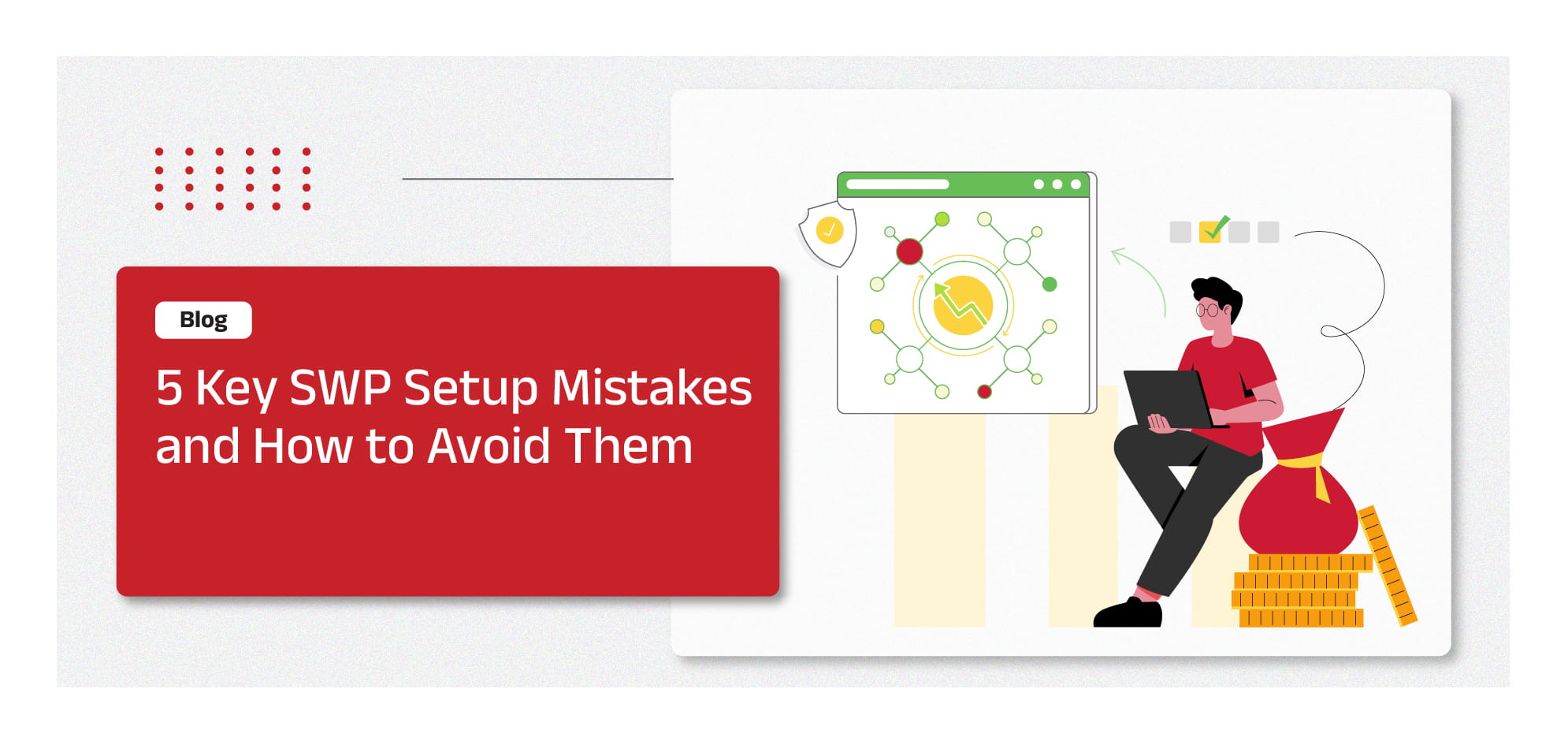-
Our Products
Our FundsFocus Funds
-
Self Care
Self-ServiceFind InformationWays To TransactPartner Solutions
-
Downloads
- Learnings
- About Us
-
More
-
Shareholders
-
Shareholders
-
Updates
-
-
SIP Calculators
- Back
-
Shareholders
5 Key SWP Setup Mistakes and How to Avoid Them

Nov 24, 2025
5 min
0 Rating
A Systematic Withdrawal Plan (SWP) is one of the most practical tools for investors seeking regular income without disturbing the long-term potential of their investments. Many people use SWP for a monthly income to manage expenses after retirement or to supplement their earnings.
Why Investors Often Misuse or Misunderstand SWP
The concept of SWP withdrawal is simple. Set an amount and frequency, and the fund takes care of the rest. But beneath that simplicity lies a need for proper planning and understanding. Investors sometimes treat SWP as a guaranteed income option, forgetting that it’s market-linked and subject to fluctuations.
Others start an SWP without considering taxation, fund type, or sustainability of withdrawals. As a result, what could have been a smart financial move turns into a poorly managed strategy. Recognising these common pitfalls is the first step toward making SWP a dependable and effective source of income.
Mistake to Avoid with SWP
Despite the benefits, investors often misuse or misunderstand how an SWP actually works. This can lead to poor results, faster depletion of funds, or tax inefficiencies. To make the most of your SWP in a mutual fund, it’s important to understand what not to do. Let’s explore the five most common mistakes investors make and how to avoid them.
Mistake 1 – Starting Without Understanding Taxation
One of the most common mistakes investors make is failing to understand how taxation applies to SWP in a mutual fund. Each withdrawal under an SWP is considered a partial redemption of units, not just profit. This means that every time you withdraw, a portion of your investment and a portion of your gains are redeemed.
The tax implication depends on how long those particular units were held before withdrawal. Ignoring this can lead to higher tax outgo, reducing the effective income you receive. Therefore, before starting an SWP, understand your investment's holding period and plan withdrawals in a tax-efficient manner.
Mistake 2 – Choosing the Wrong Fund Type
Not every mutual fund is suitable for an SWP withdrawal. The type of fund you choose plays a crucial role in determining the sustainability of your withdrawals.
For example, equity funds are more volatile but have the potential for higher long-term returns, while debt funds offer stability but lower returns. If you choose a highly volatile equity fund for monthly withdrawals, you might face challenges during market downturns, as more units may need to be redeemed to meet the withdrawal amount.
On the other hand, going for a very conservative fund could mean your returns may not even keep up with inflation.
It’d be better to match your fund choice with your risk appetite, time horizon, and income requirement. Balanced or hybrid funds can work well for SWP for monthly income, as they provide a mix of growth and stability.
Mistake 3 – Withdrawing Too Aggressively
Another major mistake is setting withdrawal amounts that are too high compared to the returns your fund can generate. When you withdraw more than your investment earns, your corpus starts to shrink faster. Over time, this can lead to premature exhaustion of funds, especially during periods of weak market performance.
Mistake 4 – Ignoring Market Conditions
An SWP in a mutual fund operates in a market-linked environment. While the concept of systematic withdrawal offers consistency, market conditions still influence your results. If you continue withdrawing a fixed amount during a prolonged market downturn, you might have to redeem more units at lower prices, leading to faster depletion of your corpus.
Conversely, during a bull market, fewer units are redeemed, and your overall investment value may rise. Ignoring these cycles can lead to imbalances in your plan.
Mistake 5 – Not Reviewing Withdrawals Periodically
Financial goals, expenses, and market conditions are never static. Yet, many investors set up an SWP and forget about it for years. This “set and forget” approach may lead to problems if your financial needs change or if your fund’s performance deviates from expectations.
Regular reviews can help your SWP for monthly income remain effective.
Avoiding Pitfalls to Make SWP More Effective
The key to making an SWP withdrawal work efficiently lies in planning and discipline. Before setting up your plan, spend time understanding how it functions, what factors affect returns, and how external elements like taxes and markets can influence outcomes.
Here are a few best practices to follow:
Choose your fund wisely based on time horizon and risk tolerance.
Set a realistic withdrawal rate that doesn’t erode your capital.
Review and recalibrate your plan periodically.
Keep track of taxation and optimise withdrawals to minimise liability.
Avoid emotional decisions during market volatility; consistency matters more.
By applying these simple yet effective habits, you can turn SWP into a steady, sustainable income source that complements your financial goals and lifestyle.
Making Your SWP Work Smarter, Not Harder
A well-planned SWP in a mutual fund can be a reliable partner in your financial journey, offering both flexibility and stability. The difference between success and disappointment often lies in avoiding common mistakes and approaching withdrawals with informed awareness. In the end, smart withdrawals are not just about income; they’re about sustaining financial confidence for life.
Disclaimers:
The information herein is meant only for general reading purposes and the views being expressed only constitute opinions and therefore cannot be considered as guidelines, recommendations or as a professional guide for the readers. The document has been prepared on the basis of publicly available information, internally developed data and other sources believed to be reliable. Recipients of this information are advised to rely on their own analysis, interpretations & investigations.
Readers are also advised to seek independent professional advice in order to arrive at an informed investment decision.
Investor are advised to consult their professional tax advisor before taking any investment decision.
Mutual Fund investments are subject to market risks, read all scheme related documents carefully.
Yes. Most mutual fund houses allow investors to pause and resume their SWP at any time. You can also adjust the withdrawal amount or frequency to suit your needs, offering flexibility and control.
It’s advisable to review your SWP at least once a year. However, if there are major market changes or personal financial shifts, an earlier review can help you realign your withdrawals.
Yes, but with caution. SWP can still provide a regular income during volatile periods, but investors should consider temporarily reducing withdrawal amounts to prevent rapid depletion of their corpus.





 1800-270-7000
1800-270-7000



